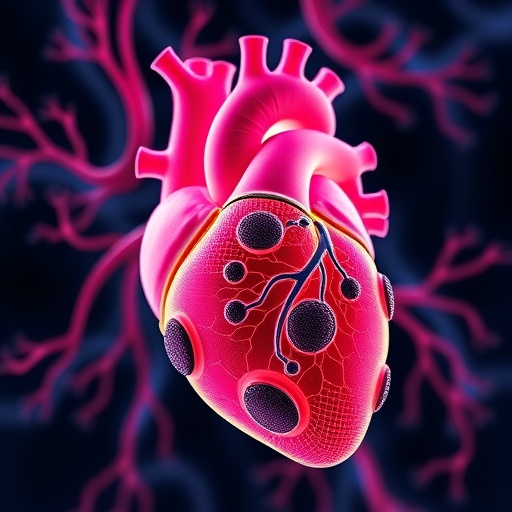Researchers at Linköping University have made significant advancements in the field of artificial heart technology by employing magnetic resonance imaging (MRI) to examine blood flow within a prosthetic heart in real time. This groundbreaking research offers new insights into how artificial hearts can be designed to mitigate prevalent issues encountered in existing models, specifically the formation of blood clots and the breakdown of red blood cells, which are critical complications affecting current artificial heart patients. The outcomes of this study were made available in the journal Scientific Reports through a collaboration with Scandinavian Real Heart AB, a company dedicated to the development of artificial heart technology.
The fundamental challenge of creating an artificial heart lies in its need to mimic the functionality of a biological heart, which tirelessly works for decades without fail. According to Tino Ebbers, a professor of physiology at Linköping University, achieving this level of reliability in a mechanical pump is an immense engineering challenge. In the quest for developing such a device, understanding the dynamics of blood flow becomes essential. The research team tackled this issue by modeling the human circulatory system at a full scale, enabling them to visually capture and analyze blood flow patterns using advanced imaging techniques.
In recent years, the global demand for heart transplants has escalated, with nearly 9,000 operations carried out worldwide annually. Despite these efforts, the waitlist for viable donor hearts continues to grow, affecting thousands of patients who find themselves tethered to mechanical pumps to sustain their blood circulation. For these individuals, an artificial heart could provide a critical lifeline while they await a transplant, allowing them a greater quality of life and the ability to spend time with loved ones instead of being confined to a hospital bed.
The researchers emphasize the critical role of continuous blood flow within an artificial heart to prevent potential complications. High velocities and turbulence can lead to hemolysis, the destruction of red blood cells, while stagnation can create ideal conditions for clot formation. The team’s groundbreaking use of MRI technology allows them to observe these dynamics in real time, fundamentally changing how artificial hearts will be optimized in the future.
Tino Ebbers highlighted the uniqueness of this imaging technology, stating that it enables scientists to visualize the conditions inside a heart without the need for invasive procedures. This non-invasive observation can revolutionize research and development in the field, yielding insights that translate directly into better-designed devices. The researchers’ analysis indicated that the blood flow patterns observed in the prototype closely resembled those found in a healthy human heart, validating their design.
The artificial heart developed by Scandinavian Real Heart recently earned the Humanitarian Use Device (HUD) designation from the US Food and Drug Administration (FDA). This status provides a pathway for the device to move through an accelerated regulatory process, potentially leading to its limited marketing and clinical application in a few years. The researchers acknowledge that while they are making strides, extensive pre-clinical and clinical studies are still necessary before the technology can be implemented in patient care.
The vision driving this research is to create an artificial heart that serves as a permanent solution rather than a temporary aid. The clinical goal is to establish the device as a bridge to transplantation, offering a reliable mechanism to keep patients alive while they await a heart from a donor. The prospect of such a device speaks to heart disease management and the future of transplantation, where reliance on human donors could be alleviated.
Patients currently reliant on mechanical support for circulation often experience a diminished quality of life. The artificial heart, if successful, could enable mobility and interaction for patients while avoiding waits in sterile hospital environments. As Ebbers articulated, bridging the gap between these patients and potential transplants could ultimately enhance their lives.
The research team at Linköping University is committed to refining this technology to address the complexities associated with artificial circulatory systems. As the interplay between speed and stagnation is adjusted in future prototypes, they aim to create more efficient designs that promote healthy blood flow and minimize complications, thereby enhancing device viability and longevity.
The advancements represented by this research illuminate a future where lives can be sustained through advanced medical devices that emulate biological systems with remarkable fidelity. By incorporating innovative imaging techniques such as real-time MRI, researchers are embarking on a transformative journey that could redefine hearts, longevity, and the very nature of organ replacement therapy.
As the technology advances, the implications stretch beyond mere functionality—they extend to ethical considerations regarding organ transplants, patient autonomy, and medical innovation in the face of an ever-growing demand for viable heart solutions.
While navigating these uncharted waters, the collaboration with Scandinavian Real Heart AB is expected to yield a wealth of clinical data and insights. The researchers remain hopeful that the artificial heart will smoothly transition from the laboratory to the clinic, heralding a new era in cardiac care that prioritizes patient well-being and quality of life.
Given the prevalence of heart conditions globally, the potential for this advanced technology to serve as a reliable heart replacement could reshape medical paradigms. The next few years will be critical in determining the success of this research and its journey toward practical application, but the momentum generated thus far is encouraging and offers hope to those waiting for heart transplants.
With the ongoing pursuit of innovation in artificial heart design, researchers and medical professionals alike are determined to pave the way for a future where dependence on donor hearts is significantly reduced, potentially revolutionizing cardiac care for generations to come.
Subject of Research: Not applicable
Article Title: 4D flow MRI enhances prototype testing of a total artificial heart
News Publication Date: 15-Sep-2025
Web References: 10.1038/s41598-025-18422-y
References: Not applicable
Image Credits: Credit: Emma Busk Winquist
Keywords
Artificial heart, blood flow, MRI, Scandinavian Real Heart, heart transplant, hemolysis, cardiac care, Tino Ebbers, Linköping University, non-invasive imaging, medical innovation, Technology, medical devices.




